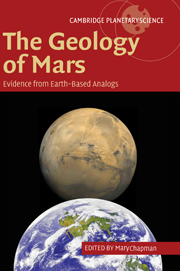Book contents
- Frontmatter
- Contents
- Preface: the rationale for planetary analog studies
- List of contributors
- 1 The geology of Mars: new insights and outstanding questions
- 2 Impact structures on Earth and Mars
- 3 Terrestrial analogs to the calderas of the Tharsis volcanoes on Mars
- 4 Volcanic features of New Mexico analogous to volcanic features on Mars
- 5 Comparison of flood lavas on Earth and Mars
- 6 Rootless volcanic cones in Iceland and on Mars
- 7 Mars interior layered deposits and terrestrial sub-ice volcanoes compared: observations and interpretations of similar geomorphic characteristics
- 8 Lava—sediment interactions on Mars: evidence and consequences
- 9 Eolian dunes and deposits in the western United States as analogs to wind-related features on Mars
- 10 Debris flows in Greenland and on Mars
- 11 Siberian rivers and Martian outflow channels: an analogy
- 12 Formation of valleys and cataclysmic flood channels on Earth and Mars
- 13 Playa environments on Earth: possible analogs for Mars
- 14 Signatures of habitats and life in Earth's high-altitude lakes: clues to Noachian aqueous environments on Mars
- 15 The Canyonlands model for planetary grabens: revised physical basis and implications
- 16 Geochemical analogs and Martian meteorites
- 17 Integrated analog mission design for planetary exploration with humans and robots
- Index
- Plate section
Preface: the rationale for planetary analog studies
Published online by Cambridge University Press: 18 September 2009
- Frontmatter
- Contents
- Preface: the rationale for planetary analog studies
- List of contributors
- 1 The geology of Mars: new insights and outstanding questions
- 2 Impact structures on Earth and Mars
- 3 Terrestrial analogs to the calderas of the Tharsis volcanoes on Mars
- 4 Volcanic features of New Mexico analogous to volcanic features on Mars
- 5 Comparison of flood lavas on Earth and Mars
- 6 Rootless volcanic cones in Iceland and on Mars
- 7 Mars interior layered deposits and terrestrial sub-ice volcanoes compared: observations and interpretations of similar geomorphic characteristics
- 8 Lava—sediment interactions on Mars: evidence and consequences
- 9 Eolian dunes and deposits in the western United States as analogs to wind-related features on Mars
- 10 Debris flows in Greenland and on Mars
- 11 Siberian rivers and Martian outflow channels: an analogy
- 12 Formation of valleys and cataclysmic flood channels on Earth and Mars
- 13 Playa environments on Earth: possible analogs for Mars
- 14 Signatures of habitats and life in Earth's high-altitude lakes: clues to Noachian aqueous environments on Mars
- 15 The Canyonlands model for planetary grabens: revised physical basis and implications
- 16 Geochemical analogs and Martian meteorites
- 17 Integrated analog mission design for planetary exploration with humans and robots
- Index
- Plate section
Summary
Just before I left to attend the June 2001 Geologic Society of London/Geologic Society of America Meeting in Edinburgh, Scotland, I received two e-mail messages. The first was from a UK-based freelance science writer, who was producing a proposal for a six-part television series on various ways that studies of the Earth produce clues about Mars. He requested locations where he might film, other than Hawaii. I was amazed that he seemed not to be aware of all of the locations on Earth where planetary researchers have been studying geologic processes and surfaces that they believe are analogous to those on Mars. In retrospect, his lack of knowledge is understandable, as no books were in existence on the topic of collective Earth locales for Martian studies and no planetary field guides had been published that included terrestrial analogs of the newly acquired data sets: Mars Global Surveyor, Mars Odyssey, Mars Exploration Rovers, and Mars Express. [Historically, NASA published a series of four Comparative Planetary Geology Field Guides with four locales having analog features for comparison with Mars, each book on a different subject and area (volcanic features of Hawaii, volcanism of the eastern Snake River Plain, aeolian features of southern California, and sapping features of the Colorado Plateau). However, all of these books were based on Viking data, intended for researchers in the field, were not widely distributed, and are now out of print (NASA has not published any more field guides).]
- Type
- Chapter
- Information
- The Geology of MarsEvidence from Earth-Based Analogs, pp. vii - xPublisher: Cambridge University PressPrint publication year: 2007
- 1
- Cited by



